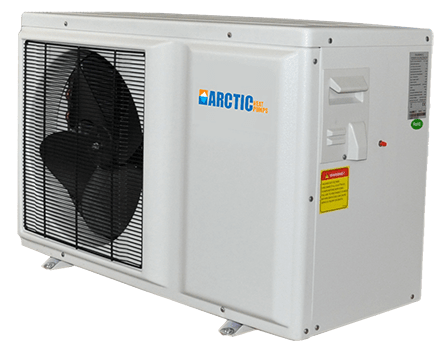Are you looking for most energy-efficient air source heat pump for cold climates? If yes, then Arctic air source heat pump is the ideal solution and works really well in North America. This heat pump is used for hydronic heating and cooling purposes.
In addition to, the Arctic series heat pumps are designed to integrate with solar thermal heating systems. As a result, you can see an uplift of further 20% in the overall efficiency and operating costs of the system. Therefore, solar thermal system is a right combination to use with an air source heat pump.

Generally, Arctic Heat Pump uses the industry-standard collector – SunRain solar vacuum tube collector which can provide hot water to the system even in the coldest North American winter. These collectors come with a 10 year warranty and are considered as the top-rated technology in North American solar industry.
However, the higher efficiency of solar vacuum tubes allows the system to produce sufficient energy during cloudy days. The efficiency rating of 80% for our solar thermal system means it absorbs and provides 80% of solar energy. When you use a solar PV panel, you’ll receive 13-16% of efficiency. Henceforth, our solar thermal systems are ideal solutions in the areas with the lowest electricity costs around the world.

The Working Principle –
Generally, solar vacuum tubes use the heat pump technology that helps in transferring solar energy to a heat bulb. The temperatures of this heat bulb can reach up to 300 C. Every collector has 20 or 30 bulbs, which are inserted into an insulated copper header that is known as heat exchanger.
After that, the heat pipes start transferring their heat energy to the header and then to the special glycol heating fluid. Every header contains around 0.6 gallons or 2.2 liters of heating fluid. A temperature sensor is inserted into the header heat exchanger.
There’s a second temperature sensor present in the bottom of the buffer tank in the heat pump. A differential controller with a pump unit senses both the temperatures. When the heating fluid in the top of collector goes above the water temperature in the tank, the pump gets activated and thereby the transfer of energy starts.
After that, hot heating fluid circulates through the large heat exchanger, present on the bottom of tank. Then, the energy is transferred to the storage and to the remaining home heating system.
The Significance of Integrating Air Source Heat Pump with Solar –
Integrating an air to water heat pump with solar is considered as ideal as they both contain the same glycol heating fluid. Both hydronic heat pumps and solar thermal system follow the same energy storage of thermal mass (buffer tank) principle.
Bottom Line –
If you’re looking to minimize energy cost, you should consider combining an air to water heat pump with solar thermal system and get an improved performance, efficiency and less operating costs. For more information about Arctic air source heat pump, please visit our website.


- -25C heat pump
- air source heat pump
- chiller for pools
- Chillers for Swimming Pools
- cold weather heat pumps
- Heat Load Design
- Heat Load Design
- Heat Loss Design Services
- Heat Pump
- Heat Pump Cold Weather
- Heat Pump for Hot Water
- Heat Pumps
- heat pumps in Nova Scotia
- Hydronic Air Handler
- Inverter Heat Pump
- Inverter Heat Pump
- radiant floor cooling
- radiant floor Design
- radiant floor Design
- radiant floor Design
- Spa Heat Pump
- Swimming Pools